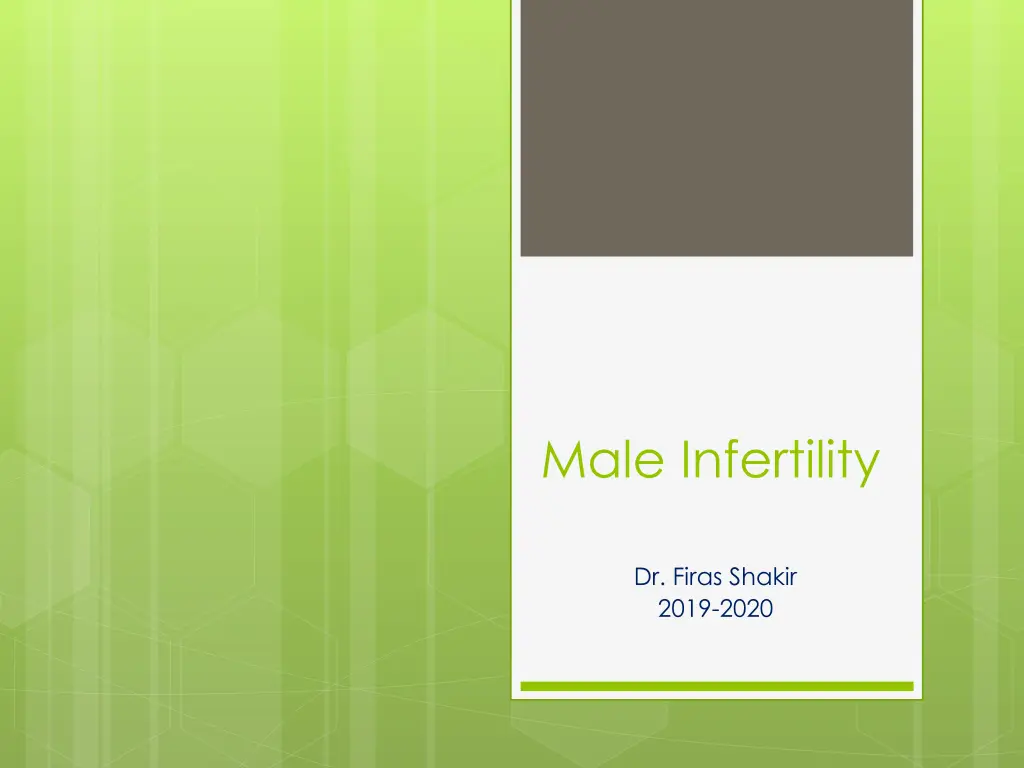
Understanding Male Infertility: Causes, Diagnosis & Management
Explore the world of male infertility, its various causes including sperm abnormalities and hormonal imbalances, common risk factors, and the approach to diagnosis through patient history, physical examination, and relevant investigations.
Download Presentation

Please find below an Image/Link to download the presentation.
The content on the website is provided AS IS for your information and personal use only. It may not be sold, licensed, or shared on other websites without obtaining consent from the author. If you encounter any issues during the download, it is possible that the publisher has removed the file from their server.
You are allowed to download the files provided on this website for personal or commercial use, subject to the condition that they are used lawfully. All files are the property of their respective owners.
The content on the website is provided AS IS for your information and personal use only. It may not be sold, licensed, or shared on other websites without obtaining consent from the author.
E N D
Presentation Transcript
Male Infertility Dr. Firas Shakir 2019-2020
Definition Failure of conception after at least 12 months of regular unprotected intercourse. Up to 50 % of infertility is due to male factors.
Pathophysiology Abnormalities of sperm morphology (teratospermia). Low sperm count (oligospermia). Abnormalities of sperm motility (asthenospermia). Absent sperms (azoospermia). Abnormal epididymal function.
Etiology Idiopathic. Varicocele . Cryptorchidism. Functional sperm disorders. Erectile or ejaculatory problems. Testicular injury. Endocrine disorders:Kallmann s syndrome.
Etiology Hormone excess. Genetic disorders:Kleinfelter s syndrome. Male genital tract obstruction. Systemic diseases. Drugs. Environmental factors. Infections.
Approach to infertile patients History : Examination: Investigations of male infertility :
Components of history Sexual and reproductive: Duration of problem; frequency and timing of intercourse; previous successful conception; birth control; erectile and ejaculatory disorders.
History Developmental: Age at puberty; history of cryptorchidism; gynaecomastia. Medical and surgical: Febrile illness ; orchitis; varicocele; testicular torsion; trauma or tumor; sexually transmitted diseases ; urinary tract infections; genitourinary and pelvic surgeries; radiotherapy; respiratory diseases; diabetes.
History Drug and environmental: Chemotherapy;nitrofurantoin; cimetidine; sulfasalazine; spironolactone; alpha blockers; exposure to heat; pesticides; dyes. Social: Ethanol, smoking/tobacco, cocaine, anabolic steroids. Family: Hypogonadism; cryptorchidism.
Physical Examination Full assessment of all systems. Signs of hypogonadism; secondary sexual development, gynaecomastia. Urogenital examination: examination of penis and testes; palpation of epididymis and vas deferense ; varicocele.
Investigations Semen analysis: 2- 3 specimens are collected over several weeks collected after 2 -7 days of sexual abstinence. Deliver specimen to lab. within one hour.
Normal parameters of semen analysis: Volume 2 mL pH 7.2-7.8 Total sperm count > 40 x 106/ ejaculate Sperm concentration > 20 x 106/ ml Sperm motility > 50% with progressive motility or >25% moving in a straight line at high speed. Sperm morphology > 15% normal forms Viability > 75% viable sperms Times to liquefy 5-25 min WBC < 1x 106WBC/ml MAR test Negative (< 10% with adherent particles)
Investigations Hormone analysis: Assessment of serum levels of FSH; LH; testosterone and prolactin. Testicular biopsy: In case of azoospermia to differentiate between obstructive and non obstructive type.
Investigations Imaging tests: 1. Scrotal ultrasound: to confirm a varicocele; and assess testicular abnormalities. 2. Transrectal ultrasound: to assess seminal vesicles and ejaculatory ducts. 3. Vasography : to visualize the vas deference for obstruction.
Options for male infertility Treatment General : modify life style and avoid risk factors. Medical treatment : 1. Antibiotics 2. Hormonal : hCG 2000 IU sc 3x a week . FSH Clomiphene citrate 25 mg . Hyperprolactinaemia is treated with dopamine agonists. 3. Antioxidants: vit. E , zinc ,folic acid.
Surgical treatment Genital tract obstruction. By microsurgical reanastomosis. Varicocele repair.
Assisted reproductive techniques Sperm extraction from the testes and subsequent assisted conception by: Intrauterine insemination (IUI). In vitro fertilization (IVF). Gamete intrafallopian transfer (GIFT). Intracytoplasmic sperm injection (ICSI).
